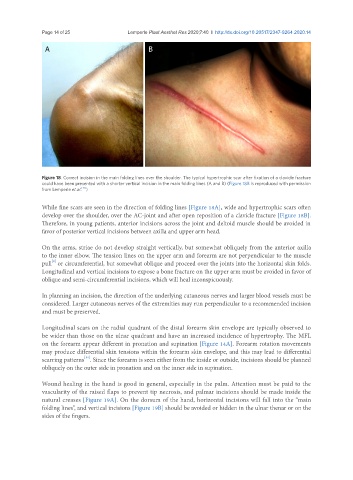Page 445 - Read Online
P. 445
Page 14 of 25 Lemperle Plast Aesthet Res 2020;7:40 I http://dx.doi.org/10.20517/2347-9264.2020.14
A B
Figure 18. Correct incision in the main folding lines over the shoulder. The typical hypertrophic scar after fixation of a clavicle fracture
could have been prevented with a shorter vertical incision in the main folding lines (A and B) (Figure 18B is reproduced with permission
[11]
from Lemperle et al. )
While fine scars are seen in the direction of folding lines [Figure 18A], wide and hypertrophic scars often
develop over the shoulder, over the AC-joint and after open reposition of a clavicle fracture [Figure 18B].
Therefore, in young patients, anterior incisions across the joint and deltoid muscle should be avoided in
favor of posterior vertical incisions between axilla and upper arm head.
On the arms, striae do not develop straight vertically, but somewhat obliquely from the anterior axilla
to the inner elbow. The tension lines on the upper arm and forearm are not perpendicular to the muscle
[4]
pull or circumferential, but somewhat oblique and proceed over the joints into the horizontal skin folds.
Longitudinal and vertical incisions to expose a bone fracture on the upper arm must be avoided in favor of
oblique and semi-circumferential incisions, which will heal inconspicuously.
In planning an incision, the direction of the underlying cutaneous nerves and larger blood vessels must be
considered. Larger cutaneous nerves of the extremities may run perpendicular to a recommended incision
and must be preserved.
Longitudinal scars on the radial quadrant of the distal forearm skin envelope are typically observed to
be wider than those on the ulnar quadrant and have an increased incidence of hypertrophy. The MFL
on the forearm appear different in pronation and supination [Figure 14A]. Forearm rotation movements
may produce differential skin tensions within the forearm skin envelope, and this may lead to differential
[14]
scarring patterns . Since the forearm is seen either from the inside or outside, incisions should be planned
obliquely on the outer side in pronation and on the inner side in supination.
Wound healing in the hand is good in general, especially in the palm. Attention must be paid to the
vascularity of the raised flaps to prevent tip necrosis, and palmar incisions should be made inside the
natural creases [Figure 19A]. On the dorsum of the hand, horizontal incisions will fall into the “main
folding lines”, and vertical incisions [Figure 19B] should be avoided or hidden in the ulnar thenar or on the
sides of the fingers.

